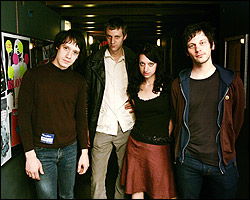ALL DUE RESPECT to the guys behind the Plexiglas and the fully loaded eggplant sandwich they hook me up with whenever I visit, my favorite thing about having lunch at Salumi is watching Seattleites sit next to complete strangers at the communal table. This place isn’t a secret anymore, so we must all eat in close proximity to each other, packed like sausage in casing. For some, this is frightening; you can see the fear of God and casual conversation in their eyes as they nudge out a chair, affect a tight smile, and scan the small room—is there really nowhere else to sit? No, there really isn’t, and like I said, that’s the best part. Eventually, the discomfort passes. I believe the fragrance of artisanal meatballs has something to do with it.
A few Fridays ago, some friends and I met Charles Smith of K Vintners at Salumi’s main table. It didn’t take long before the woman seated to my right, noting the various bottles of Smith’s brand-new releases being passed around and poured generously, put the fork down on her hot meat plate and asked what was going on. I figured her for a non-native. We introduced ourselves, and her friendly extroversion was rewarded with a healthy pour. Next thing I knew, she was on her cell phone whispering exclamation marks: “Where are you?? I’m at Salumi and Charles Smith is here—I’m drinking his wine!”
From there, things got downright European. A friend of our new friend’s showed up to join us, and Smith, all long, curly Sammy Hagar hair and roadie-warrior cool, grabbed the bottle of his ’02 El Hefe—a blend of 78 percent tempernillo and 22 percent cabernet sauvignon grapes that tastes the way a late September evening at the ocean shore feels—and took a swig straight from the neck.
K WINES INSPIRE the kind of behavior that is too often frowned upon in polite American society. You start talking with your hands and laughing too much. You want to buy a bottle for everyone in the house. It isn’t that Smith’s wines are more intoxicating—in fact, typically they’re less intoxicating; K wines, like most European wines, are lower in alcohol content than most of their domestic peers. It’s that start to finish and shelf to stomach they’re bold, and it’s a boldness you immediately believe in. They’re wines you immediately understand. You don’t have to be a studied wine drinker to pick out the layers of earth, sea, and subtle, desert fruit.
The daring and completely straightforward aesthetic isn’t a mistake—in package or in taste. Smith wants to convey honesty. He wants you to know that human hands make his wine. He wants you to trust beauty. The stark black-and-white graphic K’s that label Smith’s syrahs recall Oriental brushstroke painting or silk-screened punk posters, depending on the vintage and vineyard. His new blends bear arty, abstract grape bunches. The cork and mouth of the Walla Walla wines are dipped in heavy wax and bottled in extra thick glass. You know the sensation of pulling a piece of heavy, 180-gram vintage vinyl out of its sleeve, placing the needle into the first groove, and walking toward your favorite chair as the noise begins to bleed from the speakers? Yeah, it’s like that.
BACK AT THE communal table, the lady of the house, Armandino’s wife Marilyn, showed up for her shift at the register. Tying on her apron, she stopped by to put her hand on my friend’s shoulder and say hi. “What an interesting label,” she said, picking up one of the bottles we had drained. “Is the wine as good as the label?” I don’t think any of us answered her directly. Smith was busy comparing wine to horse racing, we were busy drinking, and our new friend was busy grinning. Nonetheless, I’m sure, the answer was loud and clear.







